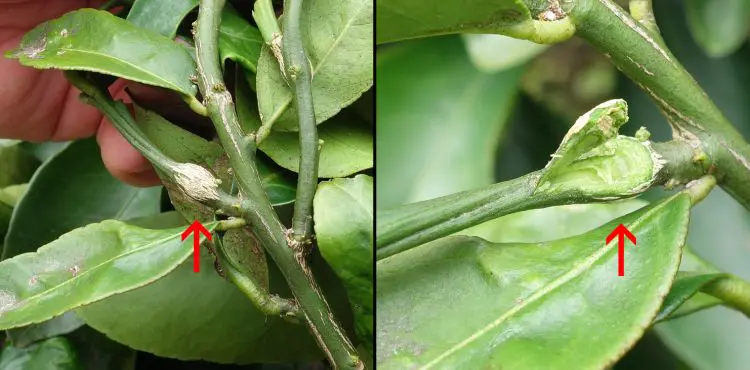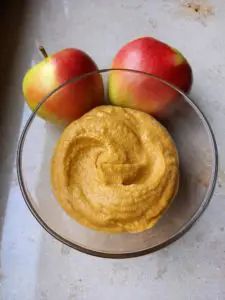Citrus are great host trees for all sort of critters- some of them beauties, some of them beasties. From the birds who swoop in on the fruit to microscopic leaf-munchers to the predators in between, citrus attracts them all. Winter tends to be something of a dormancy period for citrus. Growth slows down, water is required less often, and they get a break from pests. But summer is when all the activity starts, and all sorts of critters come out to play on your citrus trees. Today I’ll be taking a closer look at all the citrus critters and how to manage them.
Gall Wasp
This is a small wasp that lays their eggs in the sappy new branch growth of citrus trees. Gall wasps attack new growth and are particularly damaging to young trees, as the galls can stunt their development. While gall wasp won’t generally kill trees, severe and repeated infestation in established trees can reduce vigour & fruiting, plus cause dieback.
Gall wasps attack by making a tiny hole in a young branch then depositing their eggs in the soft tissue. The tree then recognises this as damage, and grows over the entry hole, thereby creating a ‘gall’. As the eggs mature into larvae the gall swells and begins to look like a lump. After several months the wasps are ready to be born, and chew their way out of the branch, causing further damage to the tree.

There are two ways to combat gall wasp. The older method is to prune the young branch off and burn it or put it into the rubbish bin. (Composting or chipping is not recommended as the galls can stay alive and potentially reinfect your other citrus). You can also solarise the infected branches by sealing them in a plastic bag and leaving it out in the sun for at least 4 days. More recently, people are slicing through the sides of the galls and leaving the branch in place. This exposes the undeveloped wasp eggs to the air and kills them.
Sooty Mould
Sooty mould looks like a layer of black dust all over your plants leaves. It is not a disease in and of itself, but is a fungal growth caused by sap sucking insects like aphids, scale, whitefly, mealybugs and mites. These insects exude a sugary substance called honeydew which the sooty mould feeds on. So the more of those insects you have, the more prolific sooty mould can be.

As the sooty mould fungi are decomposers that use the honeydew as their source of nutrition, they do not directly draw any sustenance from their host plant. Sooty mould does, however, cover leaves, block light and make photosynthesis less efficient.
Small Critters
A large number and variety of tiny insect pests attack citrus trees during the summer months. This is true no matter where you live. Aphids and scale are drawn to citrus, and can be particularly prevalent in summer. Mites, lice, woodworm, leaf miner and grasshoppers will also infest and feed on citrus foliage when the weather is warmest.

Most of these pests are easily controlled with a white oil spray. You can buy it in a spray pack, or make your own at a fraction of the cost. White oil contains a dessicant and a smothering agent, and when made at home, is an efficient organic pest control method.
An Ounce of Prevention is Better Than a Pound of Cure…Or Is It?
A common sight in the subtropical summer is netted fruit trees. It’s not difficult to do- all you need is a few stakes and some commercial netting or shadecloth or even an old lace curtain. Netting will prevent much of the potential pest damage, but there are definitely some disadvantages to using it.
During our local ‘rain bomb’ event last month (where we had 60 inches of rain in 4 days), I found that the netting encouraged many adverse health issues. Mealybugs, scale, aphids, and fungal infections all emerged. An excess of moisture and humidity alone can do damage to young trees, but with netting as well, the poorer light and airflow really exacerbated the pest issues. One tree in particular, my dwarf navel orange, really suffered. I do need to keep this tree netted for nine months of the year, otherwise the crows take all the fruit.
I’ll soon be reshaping that particular tree so that it can have a permanent frame built around it. The frame will support netting but will hold it away from the leaves so as to allow better light and air circulation. I will be able to walk around the tree to prune leaves, easily pick fruit, attend to pests, pull weeds and fix the mulch. Next month I will discuss how to easily attain various tree shapes and the methods I use, plus share my special white oil recipe.
A way to trick the baddies is to foliar feed any pest-affected trees. A good dose of nitrogen-rich foliar feed like a seaweed or fish solution with trace elements will render the plant too healthy for the bad guys. The beneficial insects will stick around the reproduce while the damaging ones move elsewhere.

Mulching
Mulch clearly isn’t a critter, but it can certainly harbour them! Having said that, mulching fruit trees is always a good idea, because it insulates the root zone, helps to maintain soil temperature and stops moisture loss. Citrus should never have mulch sitting too close to the trunk though, as they can get collar rot. Collar rot is a fungal disease which is encouraged when the soil is draining slowly and kept moist. Keeping mulch away from the trunk will prevent collar rot. This is particularly of concern in summer if like me, most of your rainfall occurs in summer. Growing lawn right up close to your citrus trees should be avoided. I know it looks nice and tidy to the eye, but lawn grass steals moisture and provides a home to root-eating grubs, among others.
A number of different types of mulch can be used, and I will delve into these in a future article. Different mulches will attract different bugs, so you do need to be mindful of which mulch you use at which time of year. Many materials can be used to give the degree of coverage and density required- some will decompose quickly and others provide a longer-lasting cover.
Beneficial Bugs
The citrus ‘beauties’, as I call them, come in many forms. My navel orange tree, for example, hosts three types of swallowtail butterflies, some mealybug destroyers, praying mantis and various wasps. The picture below shows a few that look like baddies- but in fact they will become swallowtail butterflies.

These swallowtail caterpillars will eat a few citrus leaves, but they definitely have benefits too. Some may deter other animals such as birds and lizards, some work as pollinators, while others can even ingest toxins from the trees which make their predators ill.
The humble praying mantis is enormously beneficial in the garden, and definitely not one that you want trapped inside netting or under mulch. They eat a wide variety of insects, lizards, spiders and even frogs.
Wasps eat a variety of different bugs. There are many types of wasps, but most are carnivorous creatures. Therefore, they’ll eat spiders, caterpillars, ants, bees, flies, beetles, crickets, aphids, grasshoppers, cicadas, whiteflies, and sugar cane borers.
As with everything in gardening, it’s all about striking the right balance. Too much of any one critter will always be a bad thing! Always observe your garden closely during summer when the pests are about. I like to water by hand in the afternoons, because it makes me slow down and take the time to have a good look at what is going on in my garden.













